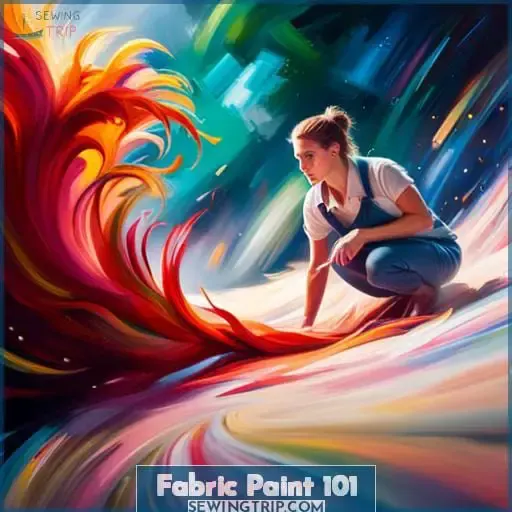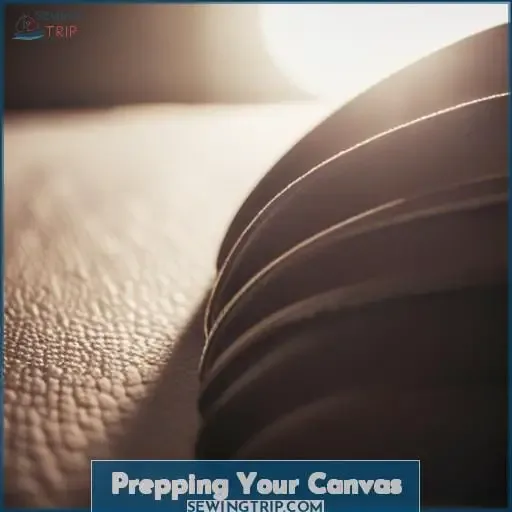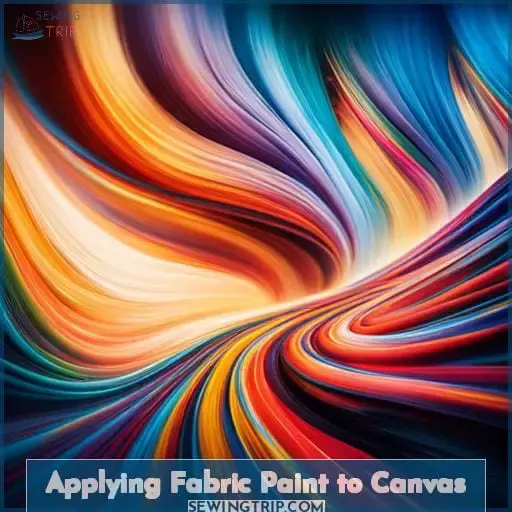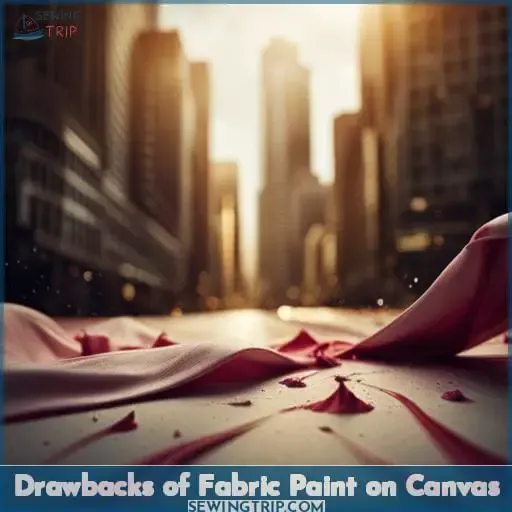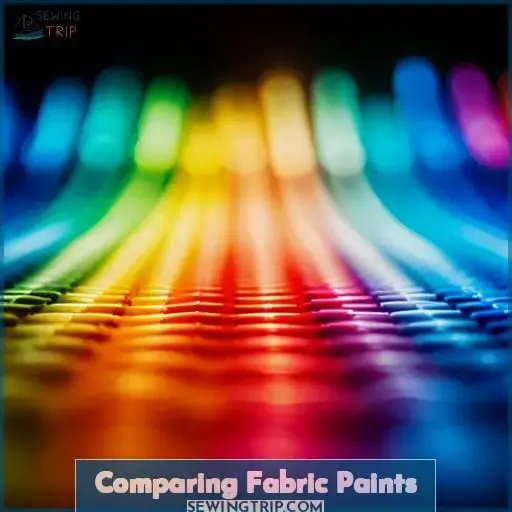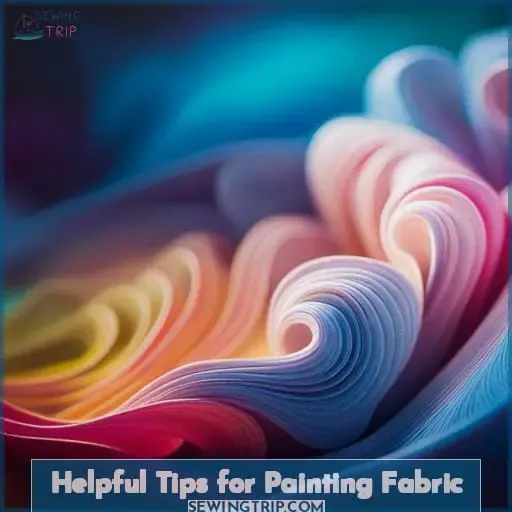This site is supported by our readers. We may earn a commission, at no cost to you, if you purchase through links.
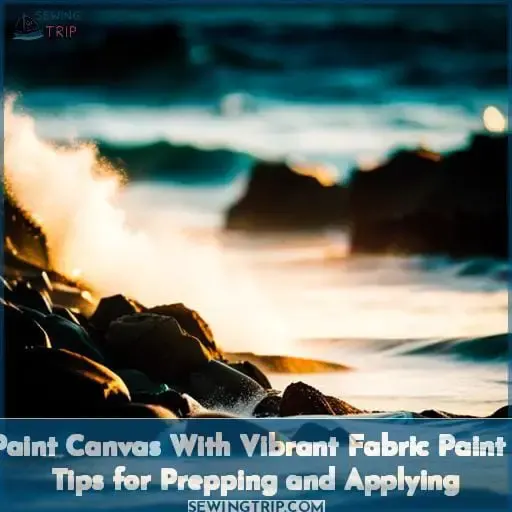 You’re itching to jazz up those plain canvas bags with some vibrant flair. I feel you! Fabric paint is the perfect way to make them pop.
You’re itching to jazz up those plain canvas bags with some vibrant flair. I feel you! Fabric paint is the perfect way to make them pop.
Let’s chat about prepping canvas, choosing fabulous paints, and expert tips to take your designs from drab to fab. This is your chance to unleash your inner creative goddess and make a statement.
Grab those bags and brushes – we’ve got this!
Table Of Contents
- Key Takeaways
- Fabric Paint 101
- Prepping Your Canvas
- Applying Fabric Paint to Canvas
- Benefits of Fabric Paint on Canvas
- Drawbacks of Fabric Paint on Canvas
- Comparing Fabric Paints
- Helpful Tips for Painting Fabric
- More Canvas Painting Inspiration
- Share Your Creations!
- Frequently Asked Questions (FAQs)
- Conclusion
Key Takeaways
- Fabric paint has brilliant, fade-resistant colors perfect for eye-catching canvas designs
- Prepare the canvas properly by priming, tightening, and stretching it before painting
- Work quickly when applying fabric paint due to its fast drying time
- Fabric paint offers unique advantages like flexibility and durability outdoors
Fabric Paint 101
When it comes to painting canvas with fabric paint, you’ll want to understand the characteristics and composition of fabric paint first.
Getting familiar with how fabric paint is made and how it differs from regular acrylic will help you use it properly on canvas projects.
Let’s break down the key traits of fabric paint before we dive into prepping and painting canvas.
Composition
How exactly is fabric paint composed?
You’re applying it directly to fabric, so it’s specially formulated to flex and move without cracking.
Fabric paint contains color pigments that are suspended in a flexible acrylic polymer emulsion.
This allows the painted design to bend and stretch with the fabric without cracking or flaking off.
Fabric paint is designed for maximum adhesion and flexibility on natural fibers like cotton, linen, silk, and wool.
When selecting fabric paints, check that they’re made for the type of fabric you plan to paint.
Characteristics
When you’re working with fabric paint, you’ll notice it has some unique characteristics that set it apart from traditional canvas paints.
Fabric paint is thicker and more vibrant, designed specifically for natural fibers like cotton canvas.
These durable paints create eye-catching designs on your canvas totes with brilliant color that won’t fade in the sun.
Experiment with techniques and colors for customized DIY bags and share your artistic, colorful creations!
Prepping Your Canvas
Before painting canvas with fabric paint, you’ll need to properly prep the surface.
Make sure to stretch and prime the canvas so it’s taut and ready for the paint.
Priming also strengthens the canvas and reveals any areas that lack tension.
Priming
You’ve got to prime your canvas before painting it with fabric paint. This prepares the surface and makes it sufficiently taut.
Apply a thin layer of gesso or acrylic primer to the canvas.
Allow the fabric paint to fully absorb.
Reveal any loose spots that need tightening.
Create a uniform surface for the best results.
Priming is an essential first step when using fabric paint on canvas. It not only preps the surface but also checks for proper tautness before you begin your vibrant masterpiece.
With the canvas ready, you can focus on rapid application and shading techniques, knowing the primer has set you up for stunning success and easier cleanup practices afterward!
Making It Taut
After priming your canvas, ensure it’s taut before applying fabric paint.
To achieve optimal tension, stretch your canvas over a wooden frame using staples or tacks, pulling each side taut as you go.
Check for any sagging areas and re-stretch if needed.
A properly stretched canvas prevents rippling or wrinkling when you start painting those vibrant designs.
Secure all edges so the fabric stays stretched tight.
A smooth, flat surface allows your creativity to really pop!
Applying Fabric Paint to Canvas
Before you start painting, sketch your design first. Consider the quick drying time of fabric paints.
Work rapidly to apply the paints in smooth, even layers. Blend colors as you go.
Clean brushes immediately after finishing to prevent the paint from drying on them.
Sketch First
You’ll usually want to sketch out your design first before applying fabric paint to canvas.
Grab your favorite sketching supplies and get creative with potential designs that inspire you.
Play with different shapes, patterns, and concepts before settling on the perfect one to bring to life.
Sketching first allows you to experiment with scale, composition, and color pairings.
It also helps ensure fabric compatibility for a cohesive and well-planned result.
This brainstorming process is invaluable for transforming basic canvas into a vibrant masterpiece.
Consider Drying Time
- Consider fabric paint’s quick drying time when planning and executing a canvas painting project.
- Work quickly or in sections.
- Have all materials ready.
- Use a hairdryer to speed drying.
- Apply thick layers rapidly.
Benefits of Fabric Paint on Canvas
You’ll love how fabric paint makes your canvas art pop with unique vibrancy and color.
It also stands up better against sun exposure and wear without cracking or fading.
With all the expanded color options, you can create canvas art that’s uniquely you.
Unique Color Vibrancy
With fabric paint on canvas, you’re getting unique color vibrancy and intensity unlike what’s possible with traditional canvas paints.
The vibrant colors of fabric paint allow for endless possibilities in your artwork. You can mix and blend colors to create stunning effects, experiment with different textures, and even use stencils to add intricate designs to your canvas creations.
Plus, fabric paint is resistant to sunlight exposure, ensuring that your vibrant colors will stay true over time.
Improved Durability Outdoors
Moreover, you’re able to display fabric-painted canvases outdoors without worrying about sun damage or other harsh weather fading or cracking the paint.
With fabric paint’s improved durability and resistance to UV rays, your vibrant art stays protected outside, so you can freely create dazzling pieces for your patio, garden, or anywhere you desire prolonged color life.
Thoughtfully seal and care for outdoor canvas to further guard your cherished creations.
Expanded Color Options
Fabric paint provides your canvas visions.
Thrive with a full spectrum of vibrant hues.
Mix colors, blend shades, get creative.
Abstract expressions, stencils, patterns – let your inner artist play.
This paint invites boundless experimenting, unlocking any design you dare to dream.
Now art your truth upon the canvas.
Drawbacks of Fabric Paint on Canvas
You’re finding fabric paint more expensive and less available than traditional canvas paints. Also, struggling with quick drying times complicating blending while diminishing durability.
Three drawbacks make fabric paint tricky for canvas painting:
- Fabric paint dries rapidly, limiting time for blending and shading colors smoothly across the canvas.
- Over time, fabric paint on canvas lacks the crack-resistance and durability of oils or acrylics, requiring touch-ups.
- Cleanup is a chore compared to water-soluble acrylics, with fabric paint residue stubbornly sticking to brushes and surfaces.
Consider these challenges before committing to fabric paint for your canvas project.
Test fabrics first and work swiftly wet-on-wet to mitigate blending difficulties from quick drying.
Limit expectations for longevity while budgeting extra for this premium paint option.
With realistic goals, fabric paint can uniquely enhance your personal canvas artistry.
Comparing Fabric Paints
You’ll need to evaluate the different fabric paint options to determine which one best meets your canvas painting needs.
Consider key factors like finish, versatility, price, and ease of use.
This comparison table outlines popular fabric paint brands and their key traits:
| Fabric Paint | Finish | Versatility | Price | Ease of Use |
|---|---|---|---|---|
| Jacquard | Matte or glossy | Most surfaces | $$ | Moderate |
| Tulip | Matte | Fabric only | $ | Beginner-friendly |
| FolkArt | Matte or glossy | Fabric, wood, more | $$ | Moderate |
| Liquitex | Matte or glossy | Fabric, canvas, more | $$$ | Advanced |
The information here is just a starting point.
Test out fabric paint samples to get a feel for factors like consistency and drying time.
Mixing paints lets you achieve custom colors and textures too.
Consider your budget, skill level, surface type, and other needs as you select the ideal fabric paint for your canvas painting project.
Helpful Tips for Painting Fabric
When prepping fabric for painting, always prewash your material first.
Test your fabric paint colors and technique on scrap pieces before starting your actual project to prevent mistakes.
And don’t forget to properly heat set your fabric paint afterward so it stays vibrant and doesn’t crack.
Prewash
The prewashing process ensures you don’t shrink the fabric after completing your artwork.
- Use hot water.
- No fabric softener.
- Air dry thoroughly.
This removes any factory chemicals that could interfere with fabric paint adhesion or cause bleeding under the stencil.
Use Barriers
After prewashing, use barriers behind the fabric you’re painting on to prevent paint bleeding.
Cardboard, plastic, or even newspaper can serve as protective barriers while unleashing your artistic vision onto fabric.
Strategically place barriers to enable boundless creativity as you paint dynamic designs.
Test Beforehand
Prior to painting on your final canvas, you’re wise to test out your fabric paints on scraps.
- Test color vibrancy.
- Judge drying time.
- Confirm washability.
- Check for bleeding.
- Perfect your technique.
Heat Setting
You’ll want to set the fabric paint using an iron to lock in the colors and designs before washing your canvas creation.
Temperature: 100 degrees Celsius
Time: 3-5 minutes
Pressure: Medium
Temperature: 212 degrees Fahrenheit
Time: 3-5 minutes
Pressure: Medium
More Canvas Painting Inspiration
You can explore more creative ways to paint on canvas after properly prepping your material.
Use techniques like ombré, splatter painting, or even mixed media with fabric.
After you’ve prepped your canvas and feel comfortable with basic fabric paint application, it’s time to unleash your inner artist.
Play with Canvas Combos by layering sheers, textiles, or found objects between coatings of paint.
Try out funky Stencil Styles, using everyday items like leaves or lace to stamp shapes.
Blend colors with abandon, allowing Fabric Paint to drip and bleed for magical effects.
Whip up custom Texture Tricks using glue, sand, or gesso under the paint.
Design totally unique DIY patterns – sketched freehand or printed from your computer.
The only limit is your imagination, so grab some canvas and get creating with fabric paint!
Share Your Creations!
You’ve painted your canvas with vibrant fabric paint, now share your one-of-a-kind creations with the community!
- Post photos in online DIY galleries and craft forums to inspire fellow artists.
- Create a showcase of your unique fabric painted canvases on your blog or social media.
- Join local craft fairs to display your artistic expressions in person.
- Sell your designs on handmade marketplaces like Etsy to fund future creative projects.
- Interact with the worldwide craft community by commenting on others’ fabric paint artwork.
Flaunt your imaginative, hand-painted canvases and exchange tips, ideas, and admiration with fellow fabric paint enthusiasts around the globe.
Frequently Asked Questions (FAQs)
What kinds of brushes or tools work best for applying fabric paint to canvas?
When applying fabric paint to canvas, use taklon brushes.
Their synthetic bristles offer control for detail work yet spring back after stroking for broader coverage too.
Alternate brush types and sizes as your design dictates.
Product specifics vary, so follow the individual paint’s label for best results across your canvas masterpiece.
How long does fabric paint take to fully cure on canvas before use?
Let the fabric paint cure fully before use, typically 24-48 hours.
Test a small area after a day; if paint rubs off, allow more drying time.
Once cured, the paint bonds durably to the canvas fibers.
Gently wash and care for the artwork, and your vibrant creation will withstand years of admiration.
Can you mix fabric paint with other mediums like textile medium or soft body acrylics?
Yes, you can mix fabric paint with textile medium or soft body acrylics to adjust thickness and flow.
However, too much acrylic paint may compromise fabric paint’s flexibility.
Test mixes on swatches first to ensure paint maintains needed elasticity for your project.
Does fabric paint work on canvas shoes and accessories?
Yes, fabric paint works nicely on canvas shoes and accessories.
Prepare the surface.
Use light coats, allowing drying time between each coat.
Set the paint once finished.
With some care when applying and washing later, the fabric paint will hold up well to wear.
What steps should you take to properly store a finished fabric painted canvas piece?
Let the painted canvas dry fully before storage.
Carefully roll or fold the canvas, avoiding creases on the painted side.
Store flat or upright in a cool, dark place like a closet or drawer.
Check periodically and refrain from stacking heavy objects on top to prevent damage over time.
Handle gently when removing for display.
Conclusion
Get ready to unleash your inner creative goddess and make a statement with vibrant fabric paint on canvas bags!
With the right prep and application techniques, you can transform those plain bags into works of art.
Whether you’re sketching first or considering drying time, these expert tips will take your designs from drab to fab.
Fabric paint offers unique color vibrancy, improved durability outdoors, and expanded color options.
So grab your brushes and let your imagination run wild – the canvas is yours to paint!

